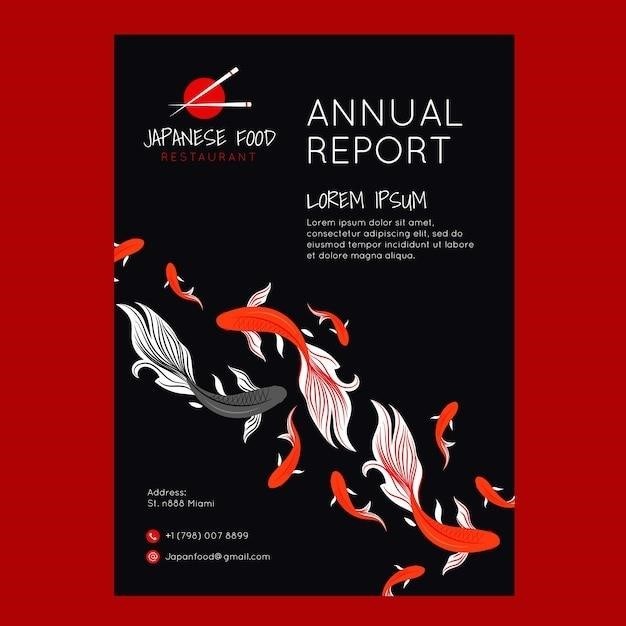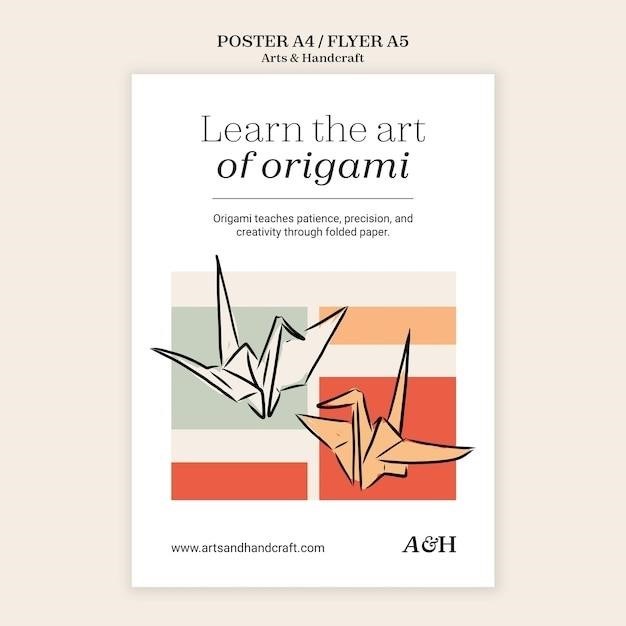Sadako and the Thousand Paper Cranes⁚ A Story of Hope and Resilience
Sadako and the Thousand Paper Cranes is a children’s historical novel written by Canadian-American author Eleanor Coerr and published in 1977․ It is based on the true story of Sadako Sasaki, a victim of the atomic bombing of Hiroshima, Japan, in World War II, who set out to create a thousand origami cranes, hoping to be granted her wish to recover from leukemia, the “atom bomb disease․” The book has become a classic and is widely read in schools and libraries around the world․ A PDF version of this book can be found online, offering readers a convenient and accessible way to experience this inspiring story․
The True Story of Sadako Sasaki
Sadako Sasaki was a young Japanese girl who was born in 1943 in Hiroshima․ She was only two years old when the atomic bomb was dropped on her city in 1945․ While she survived the initial blast, she was exposed to radiation that would later have a devastating impact on her health․ Sadako grew up seemingly healthy and active, excelling in sports, especially running․ However, her world changed when she began experiencing dizziness and fatigue, symptoms that would eventually lead to a heartbreaking diagnosis of leukemia, a disease directly linked to the radiation exposure she had endured as a child․
Sadako’s story is one of resilience and hope in the face of unimaginable adversity; She was a bright and spirited girl, determined to live life to the fullest despite her illness․ Despite the overwhelming odds, she refused to give up hope and clung to the belief that she could recover․ It was during this time that she learned about a Japanese legend⁚ if a sick person folds one thousand paper cranes, the gods will grant their wish and restore their health․
Inspired by this legend, Sadako set out to fold as many paper cranes as she could, her determination fueled by the hope of a miracle․ She spent countless hours in the hospital, folding cranes with tireless dedication․ The legend, while a source of comfort and hope, was ultimately a symbol of Sadako’s indomitable spirit, a testament to her unwavering belief in the power of hope and perseverance․
The Legend of the Thousand Paper Cranes
The legend of the thousand paper cranes, known as “Senbazuru” in Japanese, is deeply ingrained in Japanese culture and folklore․ It is a story of hope, healing, and the power of wishes․ At its core, the legend tells that anyone who folds one thousand origami cranes, the graceful and symbolic birds of peace, will have their wish granted․ This wish can range from a simple desire for good health to a more profound longing for peace and happiness․ The legend is often associated with the crane, a bird revered in Japanese culture for its longevity and graceful flight, symbolizing peace, good luck, and happiness․
The origin of the legend is unclear, but it has been passed down through generations and is often attributed to the story of a young woman who, after surviving a war, dedicated herself to folding a thousand paper cranes to honor the soldiers who had died․ She believed that if she completed this arduous task, the spirits of those lost would find peace․ This act of dedication and perseverance resonated deeply with the Japanese people and became an enduring symbol of hope and resilience․
The practice of folding paper cranes, especially in multiples of a thousand, has become a tradition in Japan, particularly for wishing for peace, good health, and happiness․ It is often used in ceremonies and rituals, and the paper cranes are frequently displayed in temples and shrines throughout the country․ The legend has transcended borders and has become a global symbol of hope and peace, especially in times of conflict and hardship․
The Impact of the Atomic Bomb on Hiroshima
The atomic bombing of Hiroshima on August 6, 1945, remains a stark reminder of the devastating consequences of nuclear warfare․ The bomb, code-named “Little Boy,” exploded with immense force, unleashing a wave of heat, radiation, and destruction that decimated the city and its inhabitants․ The immediate impact was catastrophic, with an estimated 80,000 people killed instantly and thousands more injured․ The long-term effects of the radiation were even more devastating, leading to widespread illness, including leukemia, which ultimately took the life of Sadako Sasaki, the young girl whose story inspired the book “Sadako and the Thousand Paper Cranes․”
The bombing left a lasting scar on Hiroshima, both physically and psychologically․ The city was reduced to rubble, and its infrastructure was shattered․ The survivors, known as “hibakusha,” faced a multitude of challenges, including physical injuries, radiation sickness, and psychological trauma․ They also had to grapple with the loss of loved ones and the uncertainty of the future․ The atomic bombing of Hiroshima had a profound impact on the world, raising awareness about the dangers of nuclear weapons and fueling the global movement for nuclear disarmament․
The story of Sadako Sasaki, a young girl who died from leukemia as a result of the radiation exposure, serves as a powerful testament to the enduring impact of the atomic bomb․ Her story, immortalized in the book “Sadako and the Thousand Paper Cranes,” has touched countless hearts and serves as a reminder of the importance of peace and the need to prevent such tragedies from happening again․
Sadako’s Diagnosis and Determination
Sadako Sasaki, a vibrant and energetic young girl, was only two years old when the atomic bomb devastated Hiroshima․ Though she survived the initial blast, the invisible threat of radiation poisoning lingered․ Years later, as a healthy and active schoolgirl, Sadako began experiencing dizzy spells and fatigue․ This led to a devastating diagnosis⁚ leukemia, a disease directly linked to the radiation exposure she had endured as a child․ The news was a crushing blow, but Sadako refused to succumb to despair․
Instead, she embraced an unwavering determination to fight for her life․ A friend, Chizuko, reminded her of an old Japanese legend⁚ folding a thousand paper cranes would grant a wish for recovery․ Sadako, with her characteristic spirit and resilience, set her heart on fulfilling this ancient tradition․ She began folding cranes with a quiet intensity, her fingers working tirelessly to create each intricate bird․ Her determination was fueled by her own unwavering hope and the love and support of her family and friends․
Despite the debilitating effects of her illness, Sadako’s spirit remained unbroken․ She persevered, folding cranes with a quiet determination, her actions becoming a symbol of hope and resilience in the face of adversity․ Her story would inspire countless others, demonstrating the power of the human spirit to overcome even the most challenging circumstances․

The Symbolism of the Paper Cranes
In Japanese culture, the paper crane, or origami tsuru, holds deep symbolic significance․ It represents peace, longevity, and good fortune․ The crane, with its graceful flight and long lifespan, is revered as a symbol of hope and resilience․ The act of folding a paper crane is seen as a meditative practice, a way to focus one’s intentions and channel positive energy․ This symbolic weight adds a profound layer to Sadako’s story․
Sadako’s dedication to folding a thousand cranes resonated with the Japanese people․ Her actions became a powerful testament to the enduring spirit of hope, even in the face of unimaginable tragedy․ The paper crane, once a symbol of peace and good fortune, became a powerful symbol of Sadako’s struggle and a reminder of the devastating consequences of war․ It served as a poignant reminder of the fragility of life and the enduring power of hope․
The thousand paper cranes folded by Sadako became a potent symbol of her determination and a rallying cry for peace․ Her story and the symbolism of the crane continue to inspire people around the world to strive for peace and to remember the victims of war․ The paper crane, a simple yet powerful symbol, carries with it the legacy of Sadako Sasaki, a young girl who faced adversity with courage and inspired generations with her unwavering spirit․
The Legacy of Sadako and the Thousand Paper Cranes
Sadako’s story, immortalized in Eleanor Coerr’s book, continues to resonate deeply with readers of all ages․ Her unwavering spirit and determination in the face of unimaginable suffering inspire hope and resilience․ The legacy of Sadako and the thousand paper cranes transcends the pages of the book and extends into the real world, influencing art, culture, and the ongoing pursuit of peace․ The story has become a global symbol of hope and peace, reminding people of the enduring power of the human spirit in the face of adversity․
Sadako’s story has been adapted into numerous films, plays, and other works of art, ensuring that her message of peace and hope continues to reach new audiences․ The paper crane has become an international symbol of peace, with people around the world folding cranes in honor of Sadako and the victims of war․ Thousands of paper cranes are often seen at peace memorials and gatherings, serving as a powerful reminder of the importance of peace and the enduring impact of Sadako’s story․
The story of Sadako and the Thousand Paper Cranes continues to serve as a powerful reminder of the devastating consequences of war and the importance of striving for peace․ It is a story that inspires hope and resilience, reminding us that even in the darkest of times, the human spirit can triumph․ Sadako’s legacy lives on through the paper cranes that symbolize her story, a testament to the power of hope and the enduring impact of a young girl who faced adversity with courage and grace․
The Book’s Message of Peace and Hope
At its core, “Sadako and the Thousand Paper Cranes” is a powerful testament to the enduring human spirit, even in the face of unimaginable suffering․ It emphasizes the importance of peace and the devastating consequences of war, particularly nuclear war․ The book poignantly illustrates the lasting impact of the atomic bombing of Hiroshima, not just on the immediate victims but also on subsequent generations․ Through Sadako’s story, Coerr highlights the tragic reality that war leaves behind a legacy of pain and suffering that can extend far beyond the battlefield․
Despite the darkness that surrounds her, Sadako’s story is ultimately one of hope․ Her unwavering determination to fold a thousand paper cranes, believing it would grant her wish for recovery, reflects a profound belief in the power of hope and resilience; Even as she faces her own mortality, Sadako chooses to focus on the positive, clinging to the belief that peace is possible and that her actions can contribute to a better future․
The book’s message resonates deeply with readers, reminding them that even in the face of immense challenges, hope and resilience can prevail․ It encourages readers to embrace peace, reject violence, and strive for a better world where the horrors of war are a thing of the past․ “Sadako and the Thousand Paper Cranes” is a timeless reminder that even in the darkest of times, the human spirit can find strength and hope, and that the pursuit of peace is a journey worth undertaking․
